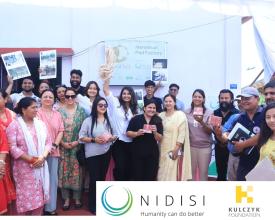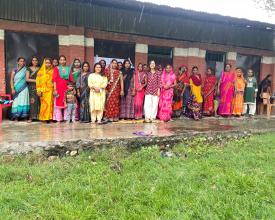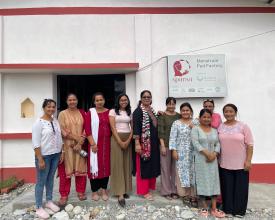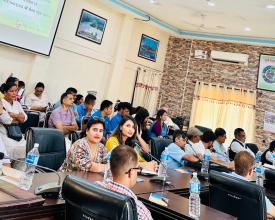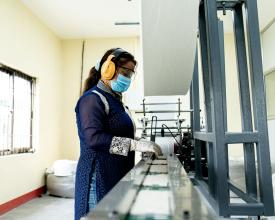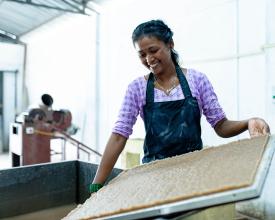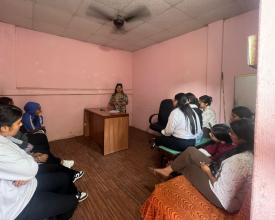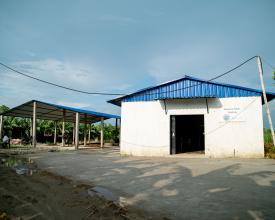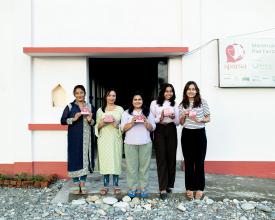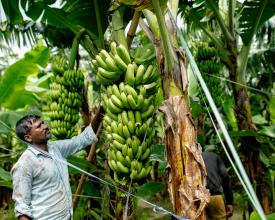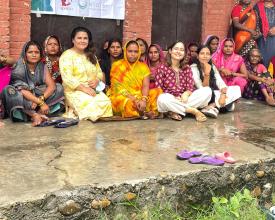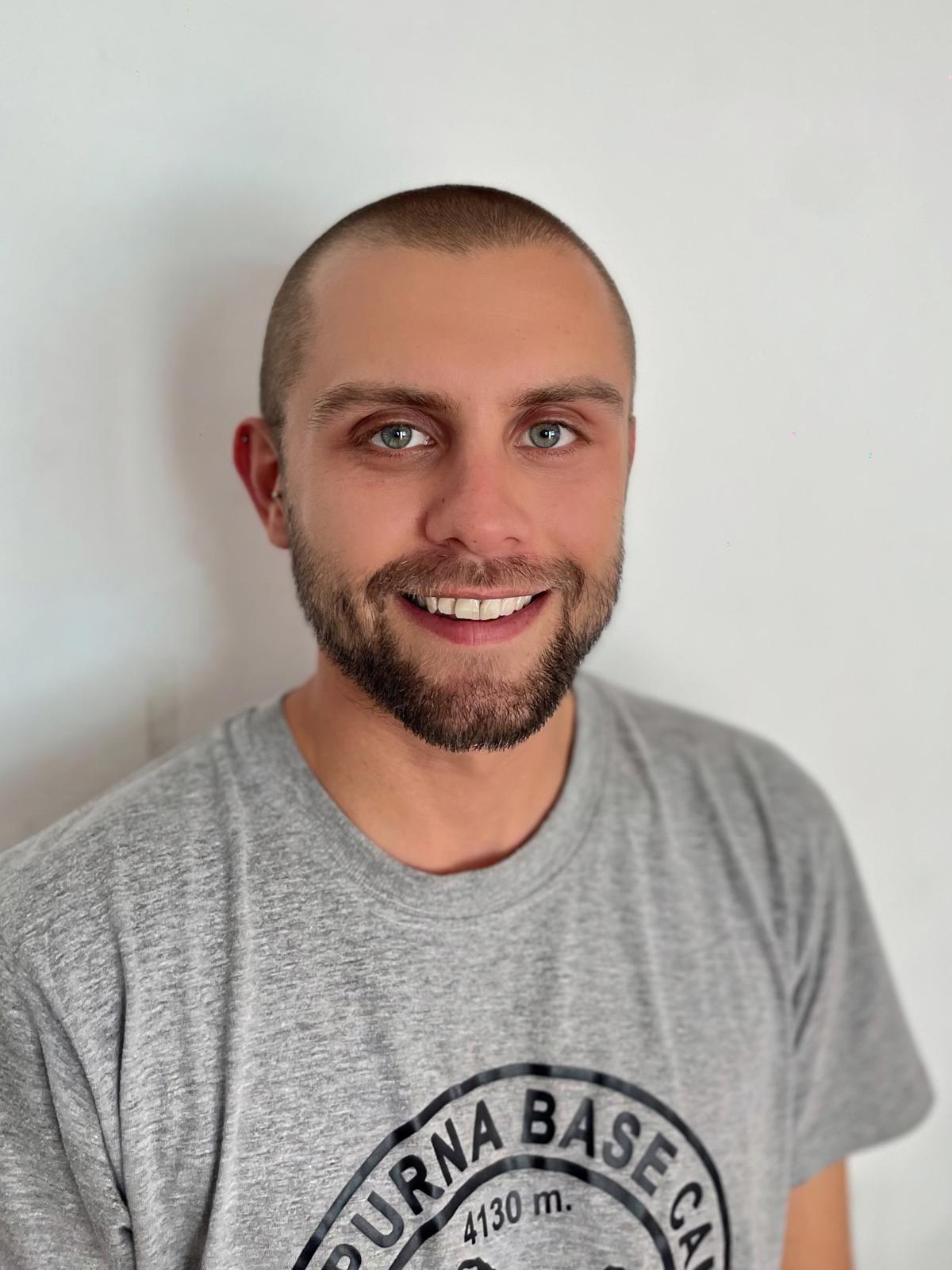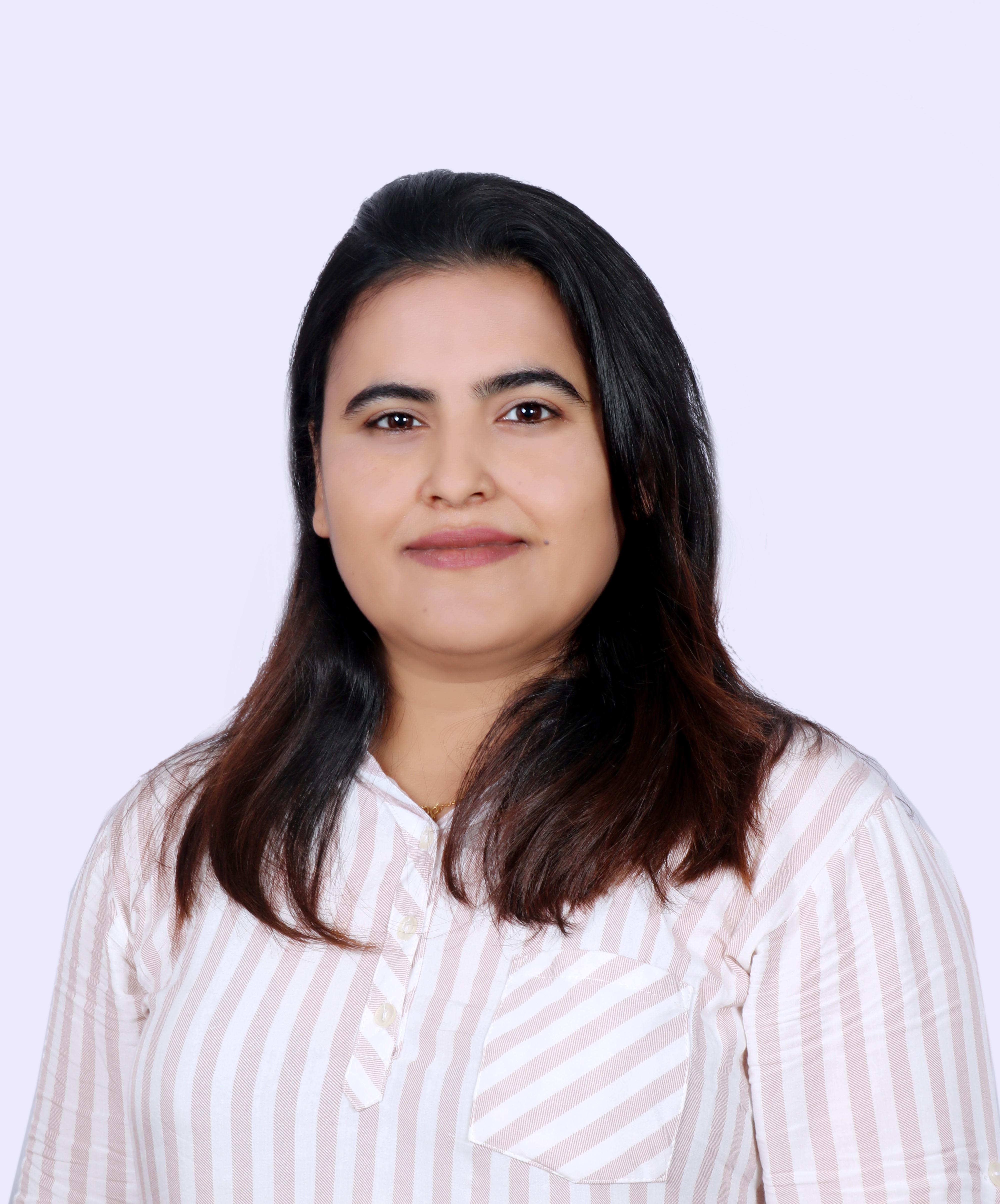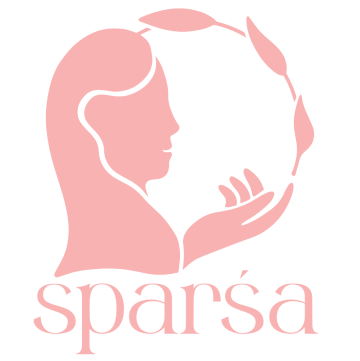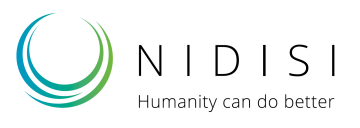
Sparsa Business Model: Gender-responsive entrepreneurship and market access
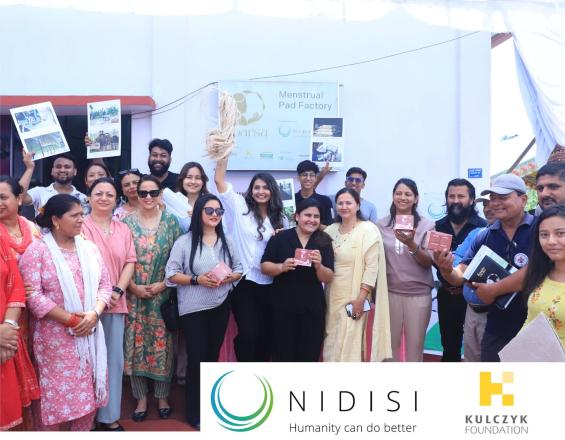
This initiative is part of the Sparsa Solution, a Nepali non-profit organization that locally produces and distributes compostable menstrual pads with an absorbent core made from banana fiber.
The Sparsa business model, rooted in gender responsive entrepreneurship and strategic market access to ensure the sustainable distribution of biodegradable menstrual pads. As a nonprofit social enterprise, Sparsa integrates ongoing market evaluation, seasonal hiring practice, and active user committees at both factory locations to enhance responsiveness and community ownership.
The model emphasizes adaptability across diverse geographic and cultural contexts and explores innovative marketing strategies such as distribution through women’s groups and community leaders. Internal and external feedback sessions are conducted to improve product quality and customer satisfaction. Strategic efforts include building a four-year financial plan, conducting market research and forming strong partnerships with NGOs, municipalities, schools, hostels
Context
Challenges addressed
Sparsa tackles environmental, social, and economic challenges in menstrual health.
Environmental: Plastic pads create huge waste problems, polluting land and water. Sparsa reduces this by producing biodegradable pads from banana fiber.
Social: Menstrual stigma limits access to safe products, especially in rural areas. Sparsa provides dignified pads, builds awareness, and ensures women’s full-time employment, promoting empowerment.
Economic: Imported pads are costly, while banana trunks go to waste after harvest. Sparsa creates local value chains, steady jobs for women, and seasonal work for men, turning waste into affordable products.
Location
Process
Summary of the process
Sparsa’s approach is built on four key elements that work together to create a strong, sustainable solution for menstrual health. We hire and train women to lead production, giving them stable jobs and building their skills. This connects directly with how and where we make our pads, using local banana fiber close to the factory. We partner with schools, NGOs, and local governments to spread awareness and distribute pads. These partnerships are stronger because they see the impact of women-led, eco-friendly production. We listen to users. Through feedback from the community, we improve our products and plan better for the future. This feedback helps guide our shift from donor-funded bulk sales to more sustainable direct-to-consumer models. All ties it together linking workers, production, community, and finances. Each block supports the next jobs support production, production builds trust, trust brings feedback, and feedback guides smart growth.
Building Blocks
Prioritizing full-time employment for women and part-time roles for men to promote gender equity in production.
This building block ensures that women are prioritized for full-time employment across Sparsa’s production value chain from manufacturing banana fiber paper at the fiber factory to producing menstrual pads at the pad factory. These roles provide women with steady income, skills training, and economic empowerment, aligning with Sparsa’s mission of gender-responsive entrepreneurship.
Men, on the other hand, are hired as seasonal workers during the banana harvest season. After farmers harvest bananas, Sparsa’s two male seasonal workers visit farms to cut and collect banana trunks, which are the raw material used to produce fiber. These trunks are then transported to the fiber factory for processing. This arrangement ensures a fair distribution of labor, with women at the core of value-added production and men supporting time-sensitive, heavy-lifting tasks during peak agricultural periods.
Enabling factors
- Strong organizational commitment to gender equity
- Clear job roles tailored to skill levels
- Local community support for employing women full-time
Lesson learned
- Offering full-time roles to women increases retention and improves product quality through consistent staffing.
- Some families were initially hesitant about women working full-time awareness and dialogue helped gain acceptance.
- Advice: Involve family or community members early in the employment process and provide orientation sessions on workplace safety and flexibility.
Strategic Partnerships and Community-Based Sales
This building block focuses on building and maintaining key partnerships with NGOs, INGOs, municipalities, schools, colleges, hostels, and health centers to expand the reach of Sparsa’s biodegradable menstrual pads. These partnerships help create demand, enable pad distribution in rural and urban areas, and build long-term relationships that promote menstrual health awareness and sustainable business models.
At both factory locations, we have formed user committees made up of local women. These women sell Sparsa pads in their communities, earn income, and help make themself and the project sustainable.
Enabling factors
- Strong Local Relationships: Trust-building with municipalities, NGOs, girls' schools/colleges, and health centers made it easier to introduce and distribute the product.
- Reliable Local Entrepreneurs: Selecting motivated local women in the community to lead pad sales ensured sustained outreach.
- Shared Vision with Partners: NGOs and INGOs working on menstrual health and gender issues were aligned with Sparsa’s mission, which enabled smoother collaboration.
- Visibility and Follow-up: Regular communication, meetings, and field visits helped maintain momentum and ensure accountability in partnerships and among entrepreneurs.
Lesson learned
What Worked Well:
- Partnering with Girls' Schools and Hostels helped us reach first-time users and young women, many of whom became regular users.
- User Committees were effective in creating a sense of ownership. Members took pride in being local sellers and advocates of a biodegradable solution.
- Municipality Endorsement helped legitimize our work and opened up funding or distribution opportunities through local government health budgets.
Challenges Faced:
- Uneven Partner Commitment: Some organizations expressed interest but lacked follow-through. Vetting partners based on past delivery capacity is essential.
- Sustaining Local Entrepreneurs: Some user committee members needed ongoing motivation, guidance, or sales training to continue actively.
Advice for Replication:
- Support Local Entrepreneurs Beyond the Initial Training: Offer refresher sessions, recognition, and a clear sales incentive model.
- Start Small and Scale with Trustworthy Partners: Pilot with a few committed institutions before expanding.
- Document Everything: Keep records of meetings, partner roles, and expectations to avoid misalignment later.
- Regular Check-Ins: Monthly or bi-monthly calls or visits help keep local committees active and reinforce accountability.
Resources
Financial Planning & Feedback Collection for Product Improvement
This building block ensures Sparsa’s financial sustainability and product-market fit through a structured 4-year financial plan and iterative feedback collection. The financial plan forecasts pad sales to track progress toward independence from donations, helping avoid budget overruns. Simultaneously, a two-phase feedback process, first with close contacts for honest critiques, then with 300+ users from schools and communities refines product quality based on real insights. By aligning finances with customer needs, Sparsa can achieve long-term viability and user satisfaction.
Enabling factors
- Local Market Knowledge – Understanding material costs, pricing trends, and purchasing behaviors to ensure accurate financial planning and competitive product pricing.
- Strong Institutional Partnerships – Close collaboration with schools, colleges, and community organizations to facilitate large-scale feedback collection and product testing.
- Technical Team Integration – Involvement of product engineers and R&D specialists in feedback analysis to directly translate user insights into pad design optimizations and quality improvements.
- Dedicated Feedback Team – A trained team to efficiently gather, analyze, and implement user insights from both initial (close network) and expanded (300+ users) feedback rounds.
- Financial Tracking Systems – Tools for real-time budget monitoring, sales forecasting, and adaptive financial adjustments to stay on track. Eg Financial sign off.
Lesson learned
- Financial Plans Require Regular Updates
A 4-year financial projection is useful for long-term vision, but real-world variables (material costs, demand shifts) require Monthly reviews to stay accurate.
- Long-Term Budgets Can Be Too Optimistic
Our 2 to 3 year goals were sometimes too ambitious compared to what we actually spent.
- Feedback Forms Should Be Simple
In the first round, our form was too long (5 pages), so even close friends didn’t finish it in given time.
- Institutional Partnerships Take Time
Schools/colleges often delayed surveys due to bureaucratic processes.
Advice
- Start small: Test financial and feedback tools in small groups before scaling up. Make your Financial plan flexible and check key numbers every month to stay on track.
- Keep it short: A one-page feedback form often gives you most of the information you need.
- Leave room for change: Set aside 15–20% of your budget for adjustments and unexpected costs.
Establishing Production and Market Entry Strategy
This building block lays the groundwork for Sparsa Pad’s operational and strategic framework by focusing on three critical aspects: location selection, organizational structure, and market approach. The banana fiber factory is strategically placed in Susta, Nepal’s largest banana farming region, ensuring direct access to the primary raw material, while the final production facility in Bharatpur as industrial hub with strong logistical networks ,enables efficient assembly and nationwide distribution. By establishing Sparsa as a non-profit, the company can foster trust with NGOs and government bodies, securing support and partnerships to distribute free pads to underserved communities. The market entry strategy follows a phased approach: For sales, we’ll start by supplying NGOs and the government (B2B) for the first two years, ensuring pads reach those who can’t afford them. Later, we’ll sell directly to customers (B2C) through retail and online for long-term growth. This plan balances social impact with sustainability.
Enabling factors
- Access to Raw Materials – Proximity to banana farms ensures a steady supply of fiber.
- Strategic Factory Locations – Susta for raw materials and Bharatpur for production/distribution.
- Government & NGO Partnerships – Support from local authorities and NGOs for funding and distribution.
- Reliable Transportation – Good road networks for moving materials and finished products.
- Skilled Workforce – Availability of trained workers for farming, factory work, and assembly.
- Market Demand – Confirmed need for affordable/reusable pads from NGOs and future retail customers.
- Legal & Regulatory Support – Smooth registration as a non-profit and compliance with manufacturing laws.
- Community Trust – Acceptance from local communities where factories operate.
Lesson learned
- Location Matters – Being close to banana farms reduces costs, but remote areas may lack infrastructure. Advice: Assess road conditions and electricity access before setting up.
- NGO Partnerships Take Time – Building trust with NGOs and government bodies requires consistent engagement. Advice: Start early and document social impact to attract supporters.
- Workforce Training is Crucial – Local workers may need training in banana fiber processing. Advice: Invest in skill development programs.
- Transportation Delays Happen – Poor roads or fuel shortages can disrupt supply chains. Advice: Have backup logistics plans and local storage.
- Balancing Non-Profit & Sustainability – Relying only on donations is risky. Advice: Gradually introduce B2C sales to ensure financial stability.
- Community Resistance Possible – Some locals may oppose factories due to noise or land use. Advice: Engage with communities early and address concerns.
Impacts
Sparsa is creating real change in three key areas, and they are environment, society, and the economy. Environmentally, our pads are 100% compostable and made from banana fiber,will help prevent about 5 tons of plastic waste by 2028. We also get banana trunks from local farmers, reducing their cost to clean agricultural waste. Socially, we’ve given full-time jobs to over 5 women and will provided 300+ schoolgirls with free pads, helping them stay in school and feel confident with the collaboration with government. Our sessions in 15+ schools reduce stigma and raise awareness. We will also trained 7+ women to sell pads in their own communities. Economically, Our pads are 3 times cheaper than other compostable pad in Nepal.
Beneficiaries
Direct: 5+ jobs, 300+ girls get pads, 7+ entrepreneurs. Indirect: Farmers profit, NGOs hit SDGs, less plastic. 9000+ gain health awareness.
Global Biodiversity Framework (GBF)
Sustainable Development Goals
Story

On May 28, 2025 World Menstrual Hygiene Day, Sparsa hosted a special event at our pad factory. We invited government officials, local leaders and community members to witness our work firsthand. The goal was simple: to showcase how a small rural factory could create safe, biodegradable menstrual pads while empowering local women and protecting the environment.
Guests toured the factory, watched the production process, and spoke with the women behind the machines. Many had never seen a pad made without plastic or a factory run mostly by women from the community. The women shared how working at Sparsa gave them financial independence and dignity. Officials saw how our work wasn’t just about products, it was about people, purpose, and impact.
The event sparked something bigger. Just two weeks later, we received a commitment of NPR 100,000 from the local government to conduct Adolescent Girls’ Health Education Program in nine schools near our factory. For us, this was more than funding, it was trust. It was recognition that our solution could create change beyond the factory walls.
Our team soon visited each school, leading sessions on menstrual hygiene, body awareness, and breaking taboos. Many girls shared that this was the first time anyone had spoken to them openly about menstruation. Some admitted they missed school during their periods because of shame or lack of products. We gave them more than just information, we gave them permission to speak, ask, and understand.
One school principal told us, “Your visit changed how our girls see themselves. They now know they’re not alone and they deserve care and dignity.” Those words stayed with us.
This experience proved that our work is not just about making pads. It’s about starting conversations, building confidence, and earning the trust of institutions. What began as a factory visit turned into a bridge between production, policy, and empowerment. It showed how even small efforts, when rooted in community and care, can create lasting change.

